Text
"I believe that humanity is meant to thrive and flourish, and that doesn't happen without context. And the arts and the humanities? They are our vessel for context." - LeVar Burton
#levar burton#humanities#art#music#education#history#national humanities medal#national endowment for the humanities
5K notes
·
View notes
Text

#Nixon50 #OTD 9/14/1973 President Nixon met with members of the National Council on the Arts and announced his nomination of Nancy Hanks for a second term as council chair. Members of the council included designer-architect-filmmaker Charles Eames, author Eudora Welty, actress Rosalind Russell, jazz pianist Billy Taylor, film director Robert Wise, artist James Wyeth, and others. (Image: WHPO-E1471-09)
#nea#national council of the arts#national endowment for the arts#charles eames#eudora welty#billy taylor#rosalind russell#robert wise#jamie wyeth
7 notes
·
View notes
Text

Mike Seeger
source: https://www.arts.gov/honors/heritage/mike-seeger
#vintage banjo#fivestringbanjo#gourd banjo#mike seeger#old time music#national endowment for the arts
6 notes
·
View notes
Photo
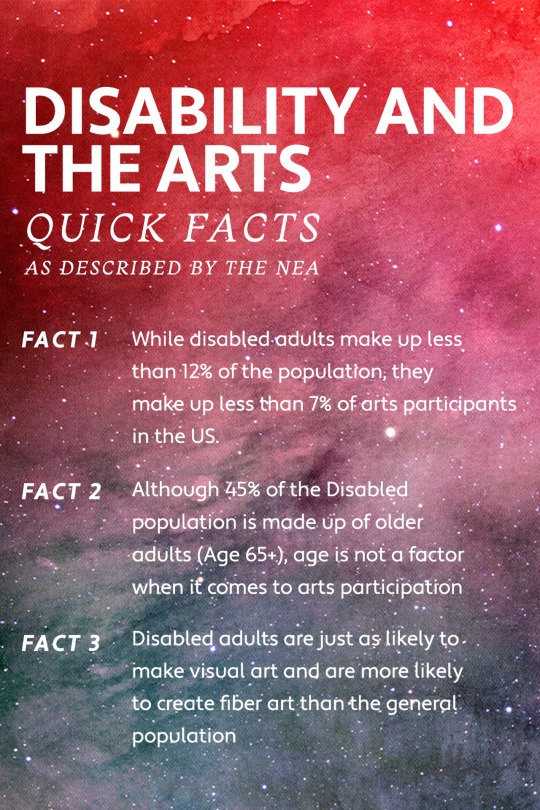
[Text Description]
Background: Galaxy with blue purple and pink ombre with tons of stars in the universe
Disability and the Arts
Quick Facts as Described by the NEA
Fact 1: While Disabled Adults make up less than 12% of the population, they make up less than 7% of arts participants.
Fact 2: Although 45% of the Disabled population is made up of older adult (Age 65+), age is not a factor when it comes to arts participation.
Fact 3: Disabled adults are just as likely to make visual art and are more likely to create fiber art than the general population.
Source: https://www.arts.gov/news/press-releases/2015/new-nea-research-arts-participation-among-people-disabilities#:~:text=Adults%20with%20disabilities%20are%20underrepresented,visiting%20art%20museums%20or%20galleries.
#disability#disabled artist#disabled musician#Arts#visual arts#performing arts#disability and the arts#chronic illne#art#arts administration#national endowment for the arts#nea#chronic illness
2 notes
·
View notes
Text
youtube
#youtube#news#Joe Biden#Arts Advocacy#National Endowment for the Arts#Public Arts#Biden#Arts Funding#National Arts#Government Event#Jill Biden#American Arts#Cultural Event#Arts and Culture#Art Appreciation#Speech#White House#Art Community#First Lady#Presidential Speech#Creative Arts
0 notes
Text
Straz Salutes Was Focus of NEA Chief’s Visit
National Endowment for the Arts Chair Maria Jackson recently visited The Straz, learning about Straz Salutes, The Straz’s multifaceted military outreach program. As one of 11 charter Creative Forces® community network organizations, the Straz Salutes program has served Tampa Bay’s military community since 2017. Funding for the program initially was supported by grants from the Creative Forces®:…
#arts#Broadway#dance#MacDill Air Force Base#music#National Endowment for the Arts#Patel Conservatory#performing arts#straz center#straz center for the performing arts#Tampa#theater#Vet-Chat
0 notes
Text
Hey, USA Tumblr people...
If you're so inclined, it would be cool if you did this.
#nea funding#neh funding#iatse#arts#public works#national endowment for the arts#national endowment for the humanities
0 notes
Text
Poetry Out Loud finals.

You can watch the competition live in person at Lisner Auditorium, The George Washington University, 730 21st Street NW, Washington, DC, or online through a one-time-only webcast at arts.gov/Poetry-Out-Loud. A total of $50,000 in awards and school or organizational stipends will be awarded at the National Finals, including $20,000 for the Poetry Out Loud National Champion. The National Finals will take place at 7:00 p.m. ET and will culminate with the live announcement of the 2024 Poetry Out Loud National Champion.
Participate on May 02nd, 2024 to the Poetry Out Loud National Finals. 07:00 pm ~ 09:00 pm ET
youtube
#poets#writing competition#writing talent#poetry#national endowment for the arts#George Washington University#Youtube
0 notes
Text
Happy birthday, Adrienne Rich!

Adrienne Cecile Rich, born May 16, 1929, in Baltimore, Maryland, and died March 27, 2012, in Santa Cruz, California, was an American poet, essayist, and feminist. She was called "one of the most widely read and influential poets of the second half of the 20th century", and was credited with bringing "the oppression of women and lesbians to the forefront of poetic discourse." Rich criticized rigid forms of feminist identities and valorized what she coined the "lesbian continuum," which is a female continuum of solidarity and creativity that impacts and fills women's lives.
Her first collection of poetry, A Change of World, was selected by renowned poet W. H. Auden for the Yale Series of Younger Poets Award. Auden went on to write the introduction to the published volume. She famously declined the National Medal of Arts, protesting the vote by House Speaker Newt Gingrich to end funding for the National Endowment for the Arts.
---
Snapshots of a Daughter-in-Law, 1963
1
You, once a belle in Shreveport, with henna-colored hair, skin like a peach bud, still have your dresses copied from that time, and play a Chopin prelude called by Cortot: "Delicious recollections float like perfume through the memory." Your mind now, moldering like wedding-cake, heavy with useless experience, rich with suspicion, rumor, fantasy, crumbling to pieces under the knife-edge of mere fact. In the prime of your life. Nervy, glowering, your daughter wipes the teaspoons, grows another way. 2 Banging the coffee-pot into the sink she hears the angels chiding, and looks out past the raked gardens to the sloppy sky. Only a week since They said: Have no patience. The next time it was: Be insatiable. Then: Save yourself; others you cannot save. Sometimes she's let the tap stream scald her arm, a match burn to her thumbnail, or held her hand above the kettle's snout right in the woolly steam. They are probably angels, since nothing hurts her anymore, except each morning's grit blowing into her eyes.
3 A thinking woman sleeps with monsters. The beak that grips her, she becomes. And Nature, that sprung-lidded, still commodious steamer-trunk of tempora and mores gets stuffed with it all: the mildewed orange-flowers, the female pills, the terrible breasts of Boadicea beneath flat foxes' heads and orchids. Two handsome women, gripped in argument, each proud, acute, subtle, I hear scream across the cut glass and majolica like Furies cornered from their prey: The argument ad feminam, all the old knives that have rusted in my back, I drive in yours, ma semblable, ma soeur! 4 Knowing themselves too well in one another: their gifts no pure fruition, but a thorn, the prick filed sharp against a hint of scorn... Reading while waiting for the iron to heat, writing, My Life had stood--a Loaded Gun-- in that Amherst pantry while the jellies boil and scum, or, more often, iron-eyed and beaked and purposed as a bird, dusting everything on the whatnot every day of life.
5 Dulce ridens, dulce loquens, she shaves her legs until they gleam like petrified mammoth-tusk. 6 When to her lute Corinna sings neither words nor music are her own; only the long hair dipping over her cheek, only the song of silk against her knees and these adjusted in reflections of an eye. Poised, trembling and unsatisfied, before an unlocked door, that cage of cages, tell us, you bird, you tragical machine-- is this fertillisante douleur? Pinned down by love, for you the only natural action, are you edged more keen to prise the secrets of the vault? has Nature shown her household books to you, daughter-in-law, that her sons never saw?
7 "To have in this uncertain world some stay which cannot be undermined, is of the utmost consequence." Thus wrote a woman, partly brave and partly good, who fought with what she partly understood. Few men about her would or could do more, hence she was labeled harpy, shrew and whore. 8 "You all die at fifteen," said Diderot, and turn part legend, part convention. Still, eyes inaccurately dream behind closed windows blankening with steam. Deliciously, all that we might have been, all that we were--fire, tears, wit, taste, martyred ambition-- stirs like the memory of refused adultery the drained and flagging bosom of our middle years. 9 Not that it is done well, but that it is done at all? Yes, think of the odds! or shrug them off forever. This luxury of the precocious child, Time's precious chronic invalid,-- would we, darlings, resign it if we could? Our blight has been our sinecure: mere talent was enough for us-- glitter in fragments and rough drafts. Sigh no more, ladies. Time is male and in his cups drinks to the fair. Bemused by gallantry, we hear our mediocrities over-praised, indolence read as abnegation, slattern thought styled intuition, every lapse forgiven, our crime only to cast too bold a shadow or smash the mold straight off. For that, solitary confinement, tear gas, attrition shelling. Few applicants for that honor. 10 Well, she's long about her coming, who must be more merciless to herself than history. Her mind full to the wind, I see her plunge breasted and glancing through the currents, taking the light upon her at least as beautiful as any boy or helicopter, poised, still coming, her fine blades making the air wince but her cargo no promise then: delivered palpable ours.
#poetry#poemsociety#poemblr#poems and poetry#poem#adrienne rich#snapshots of a daughter-in-law#santa cruz#yale series of younger poets award#national medal of arts#national endowment for the arts
1 note
·
View note
Text
StitchCast Studio LIVE! Black Youth and Juvenile Justice
StitchCast Studio LIVE! Black Youth and Juvenile Justice Episode Link: https://stitchcaststudio.podbean.com/e/blackyouthandjuvenilejustice/ Download: https://mcdn.podbean.com/mf/web/k5njy4/scs_live_youth_and_juvinile_justice_ft_ryan_vickers64x85.mp3 Story Stitchers young artists take on the topic of Black Youth and Juvenile Justice with guest Ryan Vickers, Director of the St. Louis City Youth…
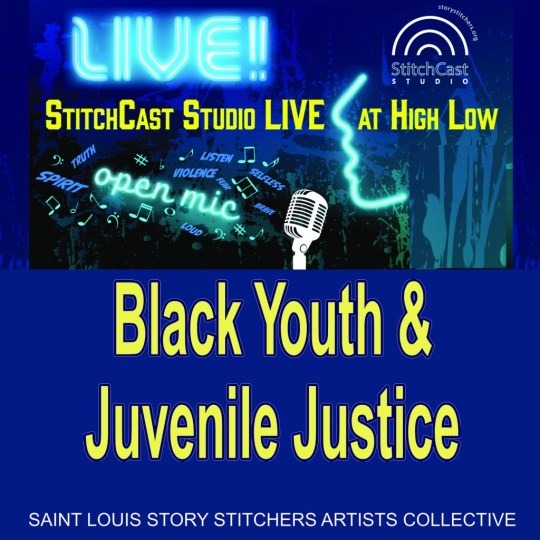
View On WordPress
#Black Youth and Juvenile Justice#creative youth development#Kranzberg Arts Foundation#National Endowment for the Arts#The Lewis Prize for Music
0 notes
Text

American Theater Is Imploding Before Our Eyes
July 19, 2023
(Long Post-Refrigerator Magnet)
By Isaac Butler
Mr. Butler is the author of “The Method: How the 20th Century Learned to Act.”
Sign up for the Opinion Today newsletter Get expert analysis of the news and a guide to the big ideas shaping the world every weekday morning.
The American theater is on the verge of collapse.
Here’s just a sampling of recent dire developments: The Public Theater announced this year that the Under the Radar festival, the most exciting of New York’s experimental performance incubators, would be postponed indefinitely and later announced it was laying off 19 percent of its staff. The Humana Festival of New American Plays, a vital launching pad for such great playwrights as Lynn Nottage and Will Eno over the past four decades, was canceled this year.
This season the Williamstown Theater Festival, one of our most important summer festivals, will consist of only one fully produced work, alongside an anemic offering of staged readings. The Signature Theater, whose resident playwrights have included Edward Albee, August Wilson, Tony Kushner and Annie Baker, is delaying the start of its season and, even then, will produce only three new plays rather than the customary six.
The Oregon Shakespeare Festival, one of the country’s oldest and most storied regional theaters, recently announced a second round of emergency fund-raising to remain operational. The Lookingglass, a major anchor of Chicago’s theater scene, is halting production for the year. The Brooklyn Academy of Music laid off 13 percent of its staff. BAM’s Next Wave Festival, which helped catapult generations of forward-thinking artists to prominence, presented 31 shows in 2017. This year, it will present seven.
Theater has always been a risky endeavor. Simon and Garfunkel’s “The Dangling Conversation” asked “Is the theater really dead?” back in 1966. The current situation, however, risks building to an unprecedented crisis: the shuttering of theaters across the country and a permanent shrinking of the possibilities of the American stage. For those of us in New York, it might be easy to look at Broadway’s return to pre-Covid audience numbers and think it signals something like normal. But Broadway in its current form depends on nonprofit theaters to develop material and support artists. Nonprofit theaters are where many recent hits — including “A Strange Loop” and “Hamilton,” both of which won Pulitzer Prizes — started out.
So how do we avoid this catastrophe? Just as in other areas of recent American life where entire industries were imperiled — banks, the auto industry — this crisis requires federal intervention.
That’s right: The American nonprofit theater needs a bailout.
Regional and nonprofit theaters were in trouble well before 2020 and the force majeure of the pandemic. Most regional and nonprofit theaters were built on a subscription model, in which loyal patrons paid for a full season of tickets upfront. Foundation grants, donations and single ticket sales made up the balance of the budgets.
For much of the 20th century, this model worked. It locked in money and audiences, mitigated the risk of new or experimental shows and cultivated a dedicated base of enthusiasts. But this model has been withering for the entire 21st century. Subscriber numbers are falling, and nothing has arisen to take the place of that revenue or that audience. Not surprisingly, ticket prices have gotten higher, making new audiences more challenging to find.
This smoldering crisis was exacerbated by the pandemic, a ruinous event that has closed theaters, broken the theatergoing habit for audiences and led to a calamitous increase in costs at a moment when they can least be absorbed. A collapse in the nonprofit sector doesn’t just mean fewer theaters and fewer shows across the country; it also means less ambitious work, fewer risks taken and smaller casts. The reverberations will be felt up and down the theatrical chain, and a new generation of talent will be neglected. As with a bank collapse, in which a few foundering institutions can bring down a whole system, the entire ecosystem of American theater is imperiled. And American theater is too important to fail.
This is why federal intervention is required. It might seem like a radical suggestion, but in fact, it’s not even new. The Federal Theater Project, which ran from 1935 to 1939, was part of the New Deal effort to fund artistic endeavors. The project sparked an explosion in theatrical activity and inspired a generation of theater makers — including Arthur Miller, Elia Kazan and Orson Welles — and through its Negro Theater Project provided targeted support for Black theater artists across the country.
From the mid-1930s to the mid-1960s, theater artists founded pioneering nonprofit companies in Oregon (Oregon Shakespeare Festival); Dallas (Theater ’47); Houston (Alley Theater); Washington, D.C. (Arena Stage); Los Angeles (Mark Taper Forum); Connecticut (Long Wharf); Kentucky (Actors Theater of Louisville); San Francisco (American Conservatory Theater); and New York City (New York Shakespeare Festival, which became the Public).
Once theaters were up and running, charitable foundations stepped in to help. The Ford Foundation, for one, provided grants to theaters beginning in the 1950s. In 1966 the National Council on the Arts announced that “the development of a larger and more appreciative audience for the theater” should be one of the primary goals of the newly formed National Endowment for the Arts. The combination of public and private sector funding that followed had a miraculous effect. By 2005, there were over 1,200 nonprofit theaters in the United States, staging 13,000 productions a year and contributing over $1.4 billion to the U.S. economy, according to the Theater Communications Group.
Now this system — which took decades to nurture, made our national theatrical culture possible and assured our place on a world stage — is falling apart. Only the federal government can provide the scope of support needed to stabilize it. One easy and immediate first step would be to pass the Creative Economy Revitalization Act and the Promoting Local Arts and Creative Economy Workforce Act, two bills that have been languishing in Congress since 2021 and 2022. These bills would immediately send millions of dollars to local artists and arts institutions across the country.
But an even more important — and formidable — step would be to greatly increase the budget of the National Endowment for the Arts. It has accomplished astounding things over its nearly 60-year history, helping to seed and sustain orchestras, theaters, museums and community arts organizations across the country. The N.E.A. has brought art outside traditional venues like playhouses and galleries and into schools and military bases. But it has never been adequately funded and since the 1980s has ludicrously become a popular piñata for conservative politicians looking to score easy points.
In the context of the federal budget, the funds required for a theatrical bailout are pocket change: For the fiscal year of 2024, the Biden administration requested $211 million for the N.E.A., or about 63 cents for every person who lives in the United States. By contrast, Arts Council England plans to distribute roughly $10 for every person in England. The N.E.A. must also once again be celebrated as an essential national organ that keeps the country’s cultural life alive.
After a series of attacks on the endowment led by the Republican senator Jesse Helms and Christian right figures like Jerry Falwell in the 1980s and ’90s, Congress changed the N.E.A.’s rules so that it can no longer give grants to individual artists, except in the field of literature, and cannot fund the general operating expenses of arts organizations. These rules — the outdated results of an earlier generation’s culture war — must be repealed.
In September 1965, President Lyndon Johnson signed into law the National Foundation on the Arts and the Humanities Act, which created the N.E.A. The act contained a long declaration of findings and purpose outlining Congress’s view as to why the arts were necessary and deserving of support. “An advanced civilization must not limit its efforts to science and technology alone,” Congress declared. “Democracy demands wisdom and vision in its citizens. It must therefore foster and support a form of education and access to the arts and the humanities, designed to make people of all backgrounds and wherever located masters of their technology and not its unthinking servants.”
These words ring even truer today. The arts nurture the human spirit, reflect the human condition for us and, at their best, allow us moments in which we can transcend the limitations of our own points of view and see the world anew. The government has long recognized that the market is not enough to sustain this project. Indeed, at times the relentless focus on shareholder value and corporate balance sheets puts the market and American art at odds.
If nonprofit theaters are to survive and fulfill their national purpose, it will take far more than cost cutting, layoffs and emergency fund-raising campaigns. Government aid is both necessary and essential, as is our nation’s renewed recognition that the arts are vital both to the survival of democracy and to the enlargement of the human spirit.
Isaac Butler is a cultural critic and the author of “The Method: How the 20th Century Learned to Act” and an author of “The World Only Spins Forward,” an oral history of “Angels in America.”
1 note
·
View note
Text
attn: the national endowment for the arts has a free magazine called 'american artscape' that issues 1-2 times a year, and you can access digital back issues or sign up for print subscription
#i just got the new issue in the mail and thought i'd share#artscape magazine#national endowment for the arts#art
1 note
·
View note
Text
Nora Ephron Looks At American Culture In 1974 - Past Daily Reference Room
Nora Ephron Looks At American Culture In 1974 – Past Daily Reference Room
Apparently, in 1974 American culture was heading down the river. https://pastdaily.com/wp-content/uploads/2012/09/where-is-american-culture-heading-1974.mp3 – National Town Meeting “Where is American Culture Heading?” August 21, 1974 – In 1974 there were grave doubts as to where we were heading as a cultural society. Although 1974 may seem like a banner year for the arts, compared to where we…

View On WordPress
#1970&039;s#1974#Anti-Intellectual#Arts#Arts Council#Arts funding#Broadcast#Broadcasts#Capitol Hill#censorship#Corporate America#culture#Culture Wars#Democracy#Discussion#Fox News#History#Interviews#National Endowment for the Arts#NEA#Nixon#Nixon Era#Nora Ephron#NPR#Past Daily#Past Daily Reference Room#Popular Culture#Presidents
0 notes
Text
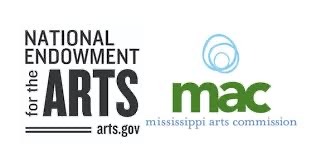
For Immediate Release
Contact: Timothy R. Collins, Artist
+1.646.371.5202 [email protected]
Timothy R. Collins Receives Mississippi Arts Commission Grant
Jackson, MS. – 12/02/2022 – Timothy R. Collins of Gore Springs, MS. Has been awarded a $500.00 grant from the Mississippi Arts Commission. This grant is a portion of the more than $1.65 million in grants MAC awarded in Fiscal Year 2023. MAC grants are made possible by continued funding from the Mississippi State Legislature and the National Endowment for the Arts.
“Our arts community is incredible, and we are very pleased to provide even more grants to artists throughout the state , nearly twice as many as last year”, said Sarah Story, executive director of MAC. “Mississippi’s artistic legacy was built through the talents of its exceptionally creative citizens. These funds help support the next generation of amazing artists and ensure that the story of artistic excellence in our state lives on.”
Timothy R. Collins:
My paintings are inspired by life, the world, and my personal experience. They’re about
the universal themes that connect all of us. My images come from all over, a photo,
sketch, the streets, visions, and memory. If it relates to the concept I’m trying to
express, I use it. The artwork reflects a longstanding relationship with abstraction, color,
materials and found objects. I want the viewer of my artwork to feel and think about
what he or she sees. To use their emotions and their imaginations, to put themselves in
my place. I’d like the audience of my pictures to stop and invest their time in what they
view. I want my work to become a mirror to the viewer showing the beauty and ugliness
that surrounds us. But in considering my work, I hope the person comes away with a
richer understanding of our world and the common thread that joins us together.
Mr. Collins artwork has been displayed in solo and group exhibitions in Chicago as well
as New York City, including The New York Public Library, The Beverly Art Center,
Gallery Guichard, the University of Illinois at Chicago, The Museum of Science and
Industry, and Gallery 312. He has received awards and grants, including The Citation
Award from Black Creativity (Museum of Science and Industry), The Best of Show from
The Beer Art Competition (Beverly Art Center), both awards received for his work called
“Emmet Till, Wolf Whistle: Before and After”. A CAAP Grant from the Department of
Cultural Affairs (Chicago, IL) and the IAS-PO Grant from the Illinois Arts Council
(Chicago, IL)
The Mississippi Arts Commission is a state agency serving more than two million people
through grants and special initiatives that enhance communities, assist artists and arts
organizations, promote arts education and celebrate Mississippi’s cultural heritage.
MAC is funded by the Mississippi Legislature, the National Endowment for the Arts, the
Mississippi Endowment for the Arts at the Community Foundation for Mississippi and
other private sources. For more information, visit www.arts.ms.gov.
For information about the Mississippi Arts Commission, please contact Ellie Banks,
Communications Director, +1.601.359.6546 or [email protected].
0 notes
Text
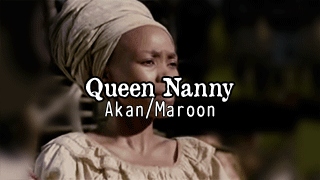




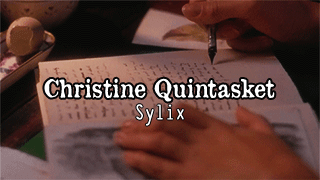

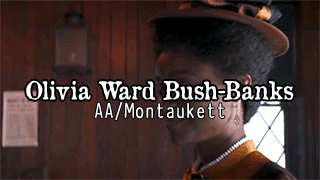
Historical Indigenous Women & Figures [6]:
Queen Nanny: the leader of the 18th century Maroon community in Jamaica, she led multiple battles in guerrilla war against the British, which included freeing slaves, and raiding plantations, and then later founding the community Nanny Town. There are multiple accounts of Queen Nanny's origins, one claiming that she was of the Akan people from Ghana and escaped slavery before starting rebellions, and others that she was a free person and moved to the Blue Mountains with a community of Taino. Regardless, Queen Nanny solidified her influence among the Indigenous People of Jamaica, and is featured on a Jamaican bank note. Karimeh Abboud: Born in Bethlehem, Palestine, Karimeh Abboud became interested in photography in 1913 after recieving a camera for her 17th birthday from her Father. Her prestige in professional photography rapidly grew and became high demand, being described as one of the "first female photographers of the Arab World", and in 1924 she described herself as "the only National Photographer". Georgia Harris: Born to a family of traditional Catawba potters, Harris took up pottery herself, and is credited with preserving traditional Catawba pottery methods due to refusing to use more tourist friendly forms in her work, despite the traditional method being much more labour intensive. Harris spent the rest of her life preserving and passing on the traditional ways of pottery, and was a recipient of a 1997 National Heritage Fellowship awarded by the National Endowment for the Arts, which is the highest honor in the folk and traditional arts in the United States. Nozugum: known as a folk hero of the Uyghur people, Nozugum was a historical figure in 19th century Kashgar, who joined an uprising and killed her captor before running away. While she was eventually killed after escaping, her story remains a treasured one amongst the Uyghur. Pampenum: a Sachem of the Wangunk people in what is now called Pennsylvania, Pampenum gained ownership of her mother's land, who had previously intended to sell it to settlers. Not sharing the same plans as her mother, Pampenum attempted to keep these lands in Native control by using the colonial court system to her advantage, including forbidding her descendants from selling the land, and naming the wife of the Mohegan sachem Mahomet I as her heir. Despite that these lands were later sold, Pampenum's efforts did not go unnoticed. Christine Quintasket: also known as "Humishima", "Mourning Dove", Quintasket was a Sylix author who is credited as being one of the first female Native American authors to write a novel featuring a female protagonist. She used her Sylix name, Humishima, as a pen name, and was inspired to become an author after reading a racist portrayal of Native Americans, & wished to refute this derogatory portrayal. Later in life, she also became active in politics, and helped her tribe to gain money that was owed them. Rita Pitka Blumenstein: an Alaskan Yup'ik woman who's healing career started at four years old, as she was trained in traditional healing by her grandmother, and then later she became the first certified traditional doctor in Alaska and worked for the Alaska Native Tribal Health Consortium. She later passed on her knowledge to her own daughters. February 17th is known as Rita Pitka Blumenstein day in Alaska, and in 2009 she was one of 50 women inducted into the inaugural class of the Alaska Women's Hall of Fame Olivia Ward Bush-Banks: a mixed race woman of African American and Montaukett heritage, Banks was a well known author who was a regular contributor to the the first magazine that covered Black American culture, and wrote a column for a New York publication. She wrote of both Native American, and Black American topics and issues, and helped sculptor Richmond Barthé and writer Langston Hughes get their starts during the Harlem Renaissance. She is also credited with preserving Montaukett language and folklore due to her writing in her early career.
part [1], [2], [3], [4], [5] Transphobes & any other bigots need not reblog and are not welcome on my posts.
544 notes
·
View notes
Text
Fishskin Robes of the Ethnic Tungusic People of China and Russia
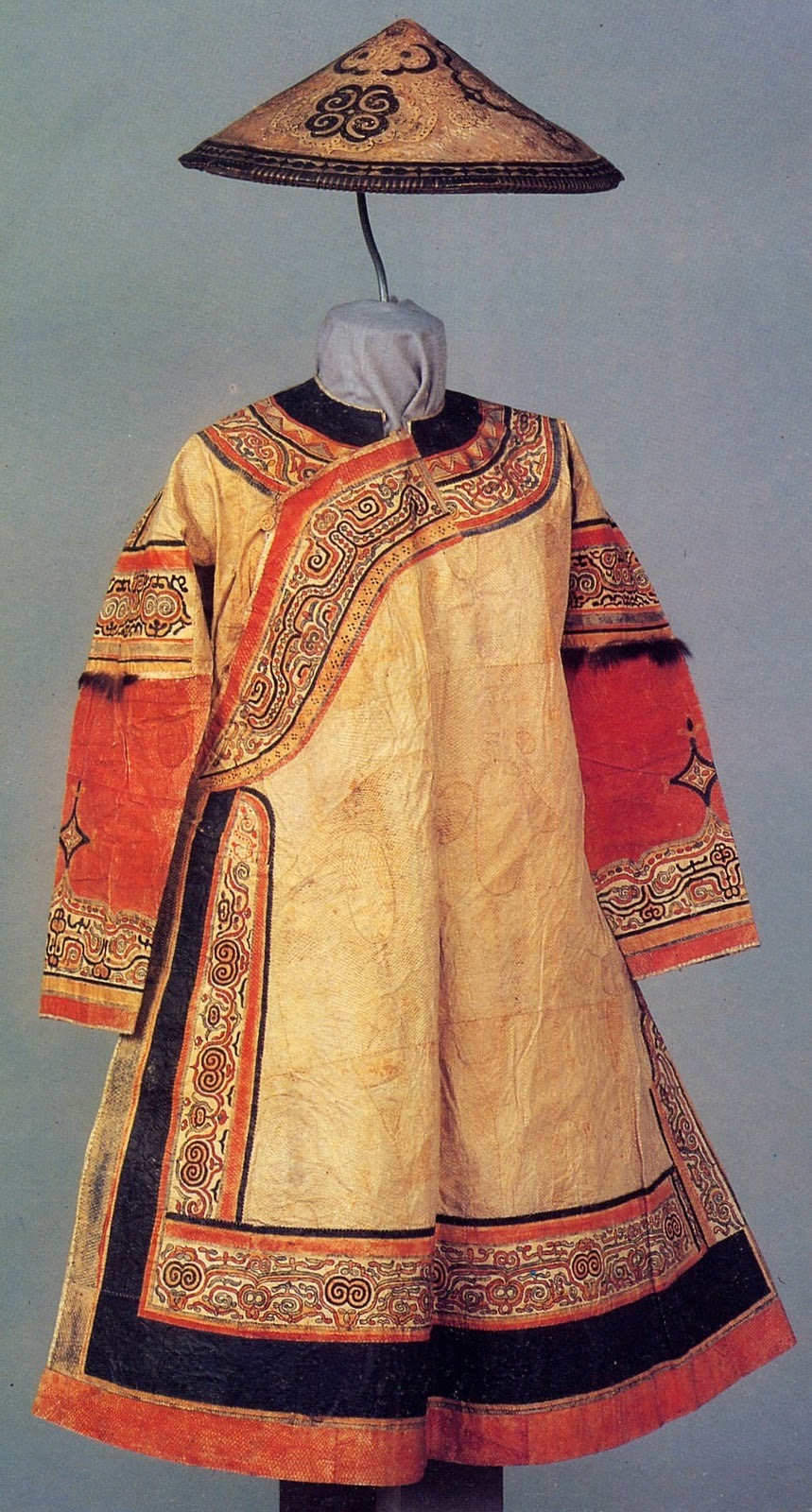
Oroch woman’s festive robe made of fish skin, leather, and decorative fur trimmings [image source].
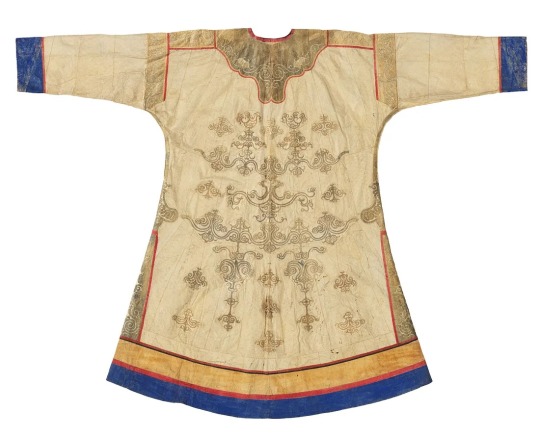
Nivkh woman’s fish-skin festival coats (hukht), late 19th century. Cloth: fish skin, sinew (reindeer), cotton thread; appliqué and embroidery. Promised gift of Thomas Murray L2019.66.2, Minneapolis Institute of Art, Minnesota, United States [image source].
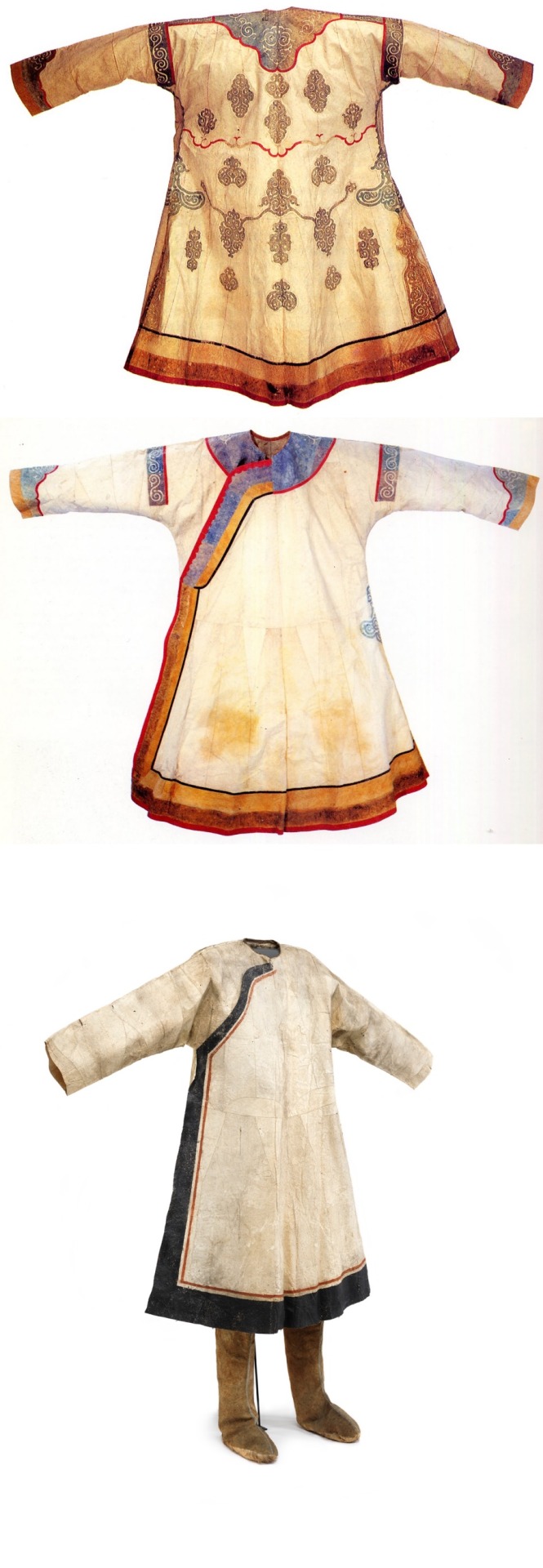
Back view of a Nivkh woman’s robe [image source].
Front view of a Nivkh woman’s robe [image source].
Women’s clothing, collected from a Nivkh community in 1871, now in the National Museum of Denmark. Photo by Roberto Fortuna, courtesy Wikimedia Commons [image source].
The Hezhe people 赫哲族 (also known as Nanai 那乃) are one of the smallest recognized minority groups in China composed of around five thousand members. Most live in the Amur Basin, more specifically, around the Heilong 黑龙, Songhua 松花, and Wusuli 乌苏里 rivers. Their wet environment and diet, composed of almost exclusively fish, led them to develop impermeable clothing made out of fish skin. Since they are part of the Tungusic family, their clothing bears resemblance to that of other Tungusic people, including the Jurchen and Manchu.
They were nearly wiped out during the Imperial Japanese invasion of China but, slowly, their numbers have begun to recover. Due to mixing with other ethnic groups who introduced the Hezhen to cloth, the tradition of fish skin clothing is endangered but there are attempts of preserving this heritage.
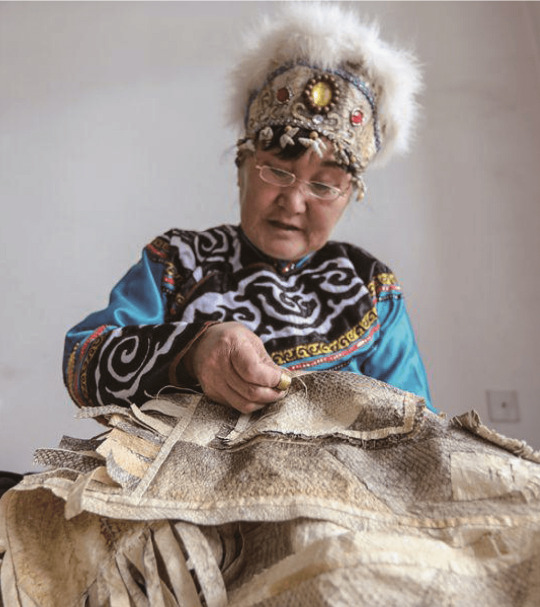
Hezhen woman stitching together fish skins [image source].


Top to bottom left: You Wenfeng, 68, an ethnic Hezhen woman, poses with her fishskin clothes at her studio in Tongjiang, Heilongjiang province, China December 31, 2019. Picture taken December 31, 2019 by Aly Song for Reuters [image source].
Hezhen Fish skin craft workshop with Mrs. You Wen Fen in Tongjian, China. © Elisa Palomino and Joseph Boon [image source].
Hezhen woman showcasing her fishskin outfit [image source].
Hezhen fish skin jacket and pants, Hielongiang, China, mid 20th century. In the latter part of the 20th century only one or two families could still produce clothing like this made of joined pieces of fish skin, which makes even the later pieces extremely rare [image source].
Detail view of the stitching and material of a Hezhen fishskin jacket in the shape of a 大襟衣 dajinyi or dajin, contemporary. Ethnic Costume Museum of Beijing, China [image source].
Hezhen fishskin boots, contemporary. Ethnic Costume Museum of Beijing, China [image source].
Although Hezhen clothing is characterized by its practicality and ease of movement, it does not mean it’s devoid of complexity. Below are two examples of ornate female Hezhen fishskin robes. Although they may look like leather or cloth at first sight, they’re fully made of different fish skins stitched together. It shows an impressive technical command of the medium.
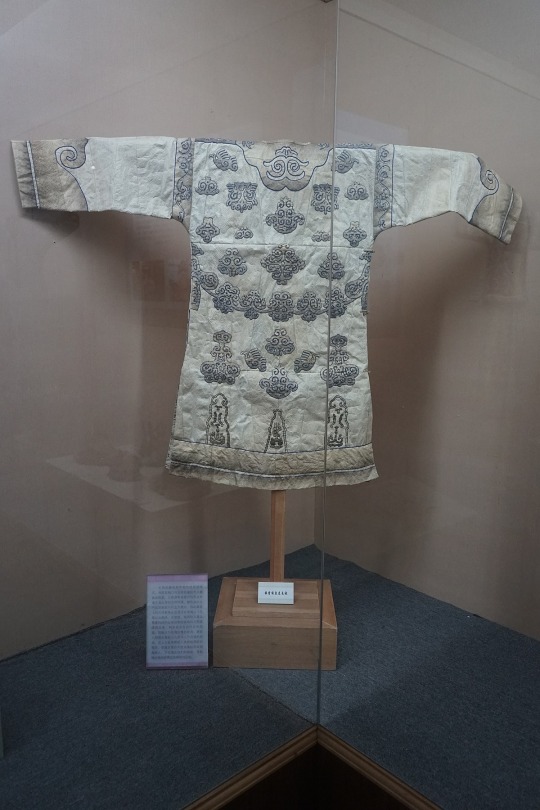
赫哲族鱼皮长袍 [Hezhen fishskin robe]. Taken July 13, 2017. © Huanokinhejo / Wikimedia Commons, CC BY 4.0 [image source].
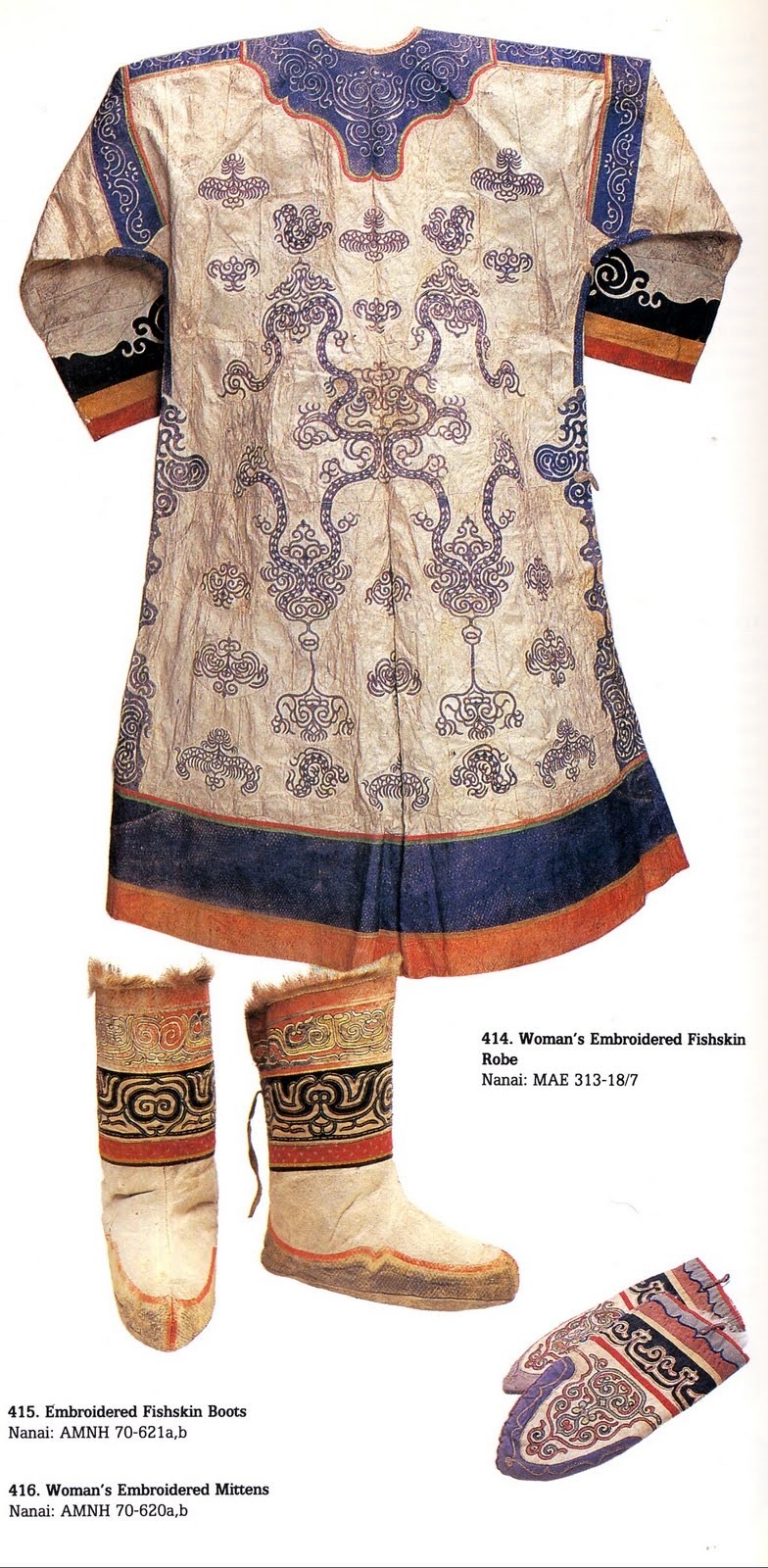
Image containing a set of Hezhen clothes including a woman’s fishskin robe [image source].
The Nivkh people of China and Russia also make clothing out of fish skin. Like the Hezhen, they also live in the Amur Basin but they are more concentrated on and nearby to Sakhalin Island in East Siberia.


Top to bottom left: Woman’s fish-skin festival coat (hukht) with detail views. Unknown Nivkh makers, late 19th century. Cloth: fish skin, sinew (reindeer), cotton thread; appliqué and embroidery. The John R. Van Derlip Fund and the Mary Griggs Burke Endowment Fund; purchase from the Thomas Murray Collection 2019.20.31 [image source].
Top to bottom right: detail view of the lower hem of the robe to the left after cleaning [image source].
Nivkh or Nanai fish skin boots from the collection of Musée du quai Branly -Jacques Chirac. © Marie-Lan Nguyen / Wikimedia Commons, CC BY 4.0 [image source].
Detail view of the patterns at the back of a Hezhen robe [image source].
Read more:
#china#russia#tungusic#hezhe#nanai#fishskin#ethnic minorities#nivkh#chinese culture#history#russian culture#amur basin#heilongjiang#east siberia#ethnic clothing
991 notes
·
View notes